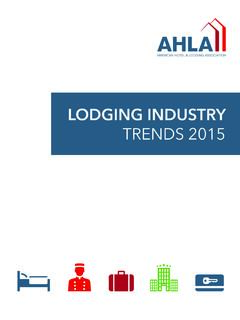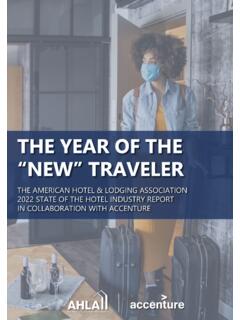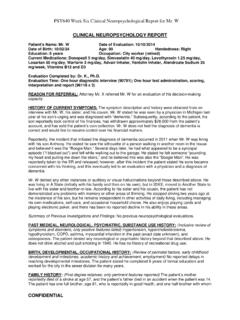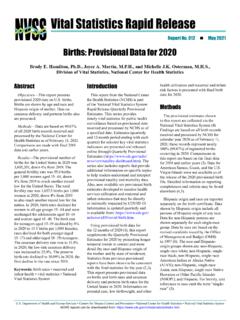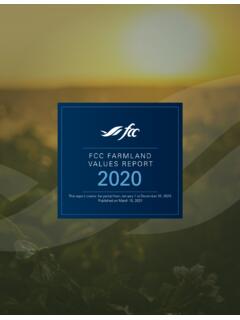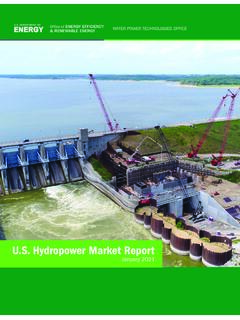Transcription of STATE OF THE HOTEL INDUSTRY ANALYSIS: COVID-19 SIX …
1 STATE OF THE HOTEL INDUSTRY ANALYSIS: COVID-19 SIX MONTHS LATER August 31, 2020 2 report : STATE OF THE HOTEL INDUSTRY ANALYSIS: COVID-19 SIX MONTHS LATER HOTEL INDUSTRY Remains On Brink of Collapse Key Findings When COVID-19 forced a virtual halt to the country, the economy and travel, the HOTEL INDUSTRY was one of the first industries affected. Unfortunately, it will also be one of the last to recoveri. Even as travel has ticked up slightly six months later, the HOTEL INDUSTRY remains on the brink of collapse. The following report outlines the current STATE of the INDUSTRY in terms of employment, consumer travel sentiment, occupancy, and INDUSTRY trends in August 2020 compared to the immediate impact of the pandemic in March and April 2020. The report outlines five key issues facing the HOTEL INDUSTRY today: 1.
2 4 Out of 10 HOTEL Employees Are Still Not Workingii: At the peak of the pandemic, nearly nine in ten hotelsiii had to lay off or furlough workers, and the hospitality and leisure INDUSTRY lost jobs. Despite small gains in employment in May and June driven largely by restaurants and bars reopening, the leisure and hospitality sector is still down jobsv since February. The accommodations sector is left with a devastating unemployment rate of 38%vi compared to the national average of 2. Almost 2/3 (65%) of Hotels Remain at or Below 50% Occupancy. That s Below the Threshold at Which Most Hotels Can Break-Even and Pay Debtviii: While leisure travelers have increased average HOTEL occupancy since the historic low of in April, thousands of hotels are at risk of closure or are unable to hire back staff due to continuing, drastically low HOTEL occupancy rates.
3 3. Consumer Travel Remains at All-Time Low: Only 33%x of Americans say they have traveled overnight for leisure or vacation since March, and only 38%xi say they are likely to do so by the end of the year. 4. INDUSTRY s Leading Employers Urban Hotelsxii Face Collapse with Cripplingly Low Occupancies: Urban hotels are major employers due to their size. But these properties are faring significantly worse than the national average, with an occupancy rate of just 38%xiii. Jobs at urban hotels are unlikely to return without either a dramatic increase in occupancy which is unlikely or additional Congressional action. 5. COVID s Impact on HOTEL INDUSTRY Felt in Major Cities Across The Country: COVID has left hotels in major cities across the country struggling to stay in business, resulting in massive job loss and dramatically reducing STATE and local tax revenue for 2020xiv and beyond.
4 Hotels are central to getting our economy back on track and supporting millions of jobs across the country. A full rebound in travel is years away, and Congressional support is urgently needed to bring our employees back, keep our doors open and survive through this crisis. To learn more about AHLA s Roadmap to Recovery with recommended policy solutions, visit HERE or contact your elected official today. 3 report : STATE OF THE HOTEL INDUSTRY ANALYSIS: COVID-19 SIX MONTHS LATER Five Key Issues Facing the HOTEL INDUSTRY Today 1. 4 Out Of 10 HOTEL Employees Are Still Not Workingxv The COVID-19 crisis has had a devastating effect on our workforce. At the peak of the pandemic, nearly nine in ten hotelsxvi had to lay off or furlough workers, and the hospitality and leisure INDUSTRY lost jobs.
5 Despite small gains in employment in May and June driven largely by restaurants and bars reopening, the leisure and hospitality sector is still down jobs since February. The accommodations sector is left with a devastating unemployment rate of 38%xix compared to the national average of Additionally, only 37%xxi of hotels have been able to bring back at least half of their full-time employees, while 36%xxii have been unable to bring back ANY furloughed or laid off staff. With nearly half of direct HOTEL operations employees still laid off or furloughedxxiii, HOTEL workers are losing more than $ billionxxiv in earnings each week. 16,496 16,473 16,494 16,507 16,519 16,526 16,528 8,549 9,954 11,935 12,527 - 2,000 4,000 6,000 8,000 10,000 12,000 14,000 16,000 18,000 JanFebMarAprMayJunJulNumber of Jobs (in 000)Leisure & Hospitality Jobs(Source: Bureau of Labor Statistics)20192020 4 report : STATE OF THE HOTEL INDUSTRY ANALYSIS: COVID-19 SIX MONTHS LATER 2.
6 Almost 2/3 (65%) of Hotels Remain At Or Below 50% Occupancy. That s Below The Threshold At Which Most Hotels Can Break-Even And Pay Debtxxv In April, 8 out of 10 HOTEL roomsxxviixxviiixxvi were empty. In August, 5 out of 10 HOTEL rooms are still empty with little expectations that occupancies will pick up until at least 2021. In fact, 65% of hotels are at or below 50% occupancy, which is near the threshold at which most hotels can break-even with expenses and pay for their debt. Thousands of hotels are at risk of closure, and their employees are facing the possibility of permanent job loss. Occupancy(Source: STR. 2020 CoStar Realty Information, Inc)20192020 5 report : STATE OF THE HOTEL INDUSTRY ANALYSIS: COVID-19 SIX MONTHS LATER 3. Consumer Travel Remains At All-Time Low While most hotels have reopened for business, many consumers have yet to resume traveling.
7 A recent survey found that only 33%xxix of Americans have traveled for leisure or vacation since March, and only 38%xxx say they are likely to do so by the end of the year. Usually 70% of Americans take a vacation in any given yearxxxi, suggesting that leisure travel is a long way from pre- COVID-19 levels. Aug12%Sep-Nov21%Nov-Jan18%Jan-Aug 202128%Post Aug 202115%None planned6%Next Expected HOTEL Stay(Source: Morning Consult, Commissioned by AHLA) 6 report : STATE OF THE HOTEL INDUSTRY ANALYSIS: COVID-19 SIX MONTHS LATER Many individuals are also hesitant to travel for upcoming holidays, exasperating already low HOTEL occupancy levels. Currently, HOTEL reservations for the Labor Day holiday week are down 65%xxxiixxxiii compared to last year, with only 14% of hotels being reserved for the holiday.
8 41%14%20192020 Percent of HOTEL RoomsBooked For Labor DayBookings Two Weeks Before Holiday(Source: Amadeus Demand360 as of 8/21/2020)2019202016%25%29%Labor DayThanksgivingChristmasPercent of Americans Traveling For Upcoming Holidays:(Source: Morning Consult, Commissioned by AHLA) 7 report : STATE OF THE HOTEL INDUSTRY ANALYSIS: COVID-19 SIX MONTHS LATER 4. INDUSTRY s Leading Employers Urban Hotelsxxxiv Face Collapse With Cripplingly Low Occupancies Nationally, average HOTEL occupancy reached 50%xxxvixxxvii, respectively. Including hotels temporarily closed duexxxviiixxxv in August, but hotels in urban markets and near airports are facing cripplingly low occupancy rates of 38% and 45% to the pandemic, urban hotels room revenues were down 78% in July. Many of these hotels rely on groups, meetings, and business travelers, which are currently nonexistent and unlikely to return until at least 2021.
9 Meanwhile, vacationers are opting for drive-to destinations, smaller markets, and beaches and other outdoor spaces. As a result, occupancy has declined by 50%xxxix year over year at urban hotels, and by 40%xl at airport hotels. Additionally, since urban hotels are major employers due to their size, jobs at urban hotels are unlikely to return without either a dramatic increase in occupancy which is unlikely or additional Congressional support. 89%79%86%71%83%75%38%52%45%54%46%58%Hote l Occupancy: August 9-15(Source: STR. 2020 CoStar Realty Information, Inc)2019202093%85%91%78%95%79%17%27%23%2 6%13%25% HOTEL Occupancy: April 12-18(Source: STR. 2020 CoStar Realty Information, Inc)20192020 8 report : STATE OF THE HOTEL INDUSTRY ANALYSIS: COVID-19 SIX MONTHS LATER 5. COVID s Impact On HOTEL INDUSTRY Felt In Major Cities Across The Country America s hotels are an economic engine, powering communities across the country.
10 Prior to this pandemic, the HOTEL INDUSTRY employed 1 in 25 American jobsxliiixli millionxlii in total. Hoteliers are proud to be an integral part of communities in every Congressional district in America, contributing $660 billion annually to GDP and supporting nearly $395 billionxliv in wages, salaries, and other compensation. Moreover, for every $100 HOTEL guests spend on lodging, another $222 is spent at the destination totaling $278 billionxlv per year spent on transportation, dining, shopping, etc. at businesses during stays. Yet, COVID-19 has left cities, especially urban markets, across the country struggling to stay in business, resulting in massive job loss and dramatically reducing STATE and local tax revenue for 2020 and beyond. In the 25 markets defined by STR as the largest HOTEL markets in the United States, the markets that have been most negatively impacted by COVID-19 continue to see an average occupancy of 50%xlvi less year over year.

